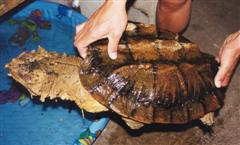Mata Mata Turtle
Matamata Turtle Scientific Name: Chelus fimbriatus
Sun, 15th June, 2025 - 6:57 am GMT
Sponsor Ads:

Alternative Name
Matamata Turtle Scientific Name: Chelus fimbriatusBasic Info
The Mata Mata Turtle can weigh up to 27 pounds, making him one of the largest freshwater turtles. Their shells can measure 18 inches in length at maturity. Females are generally larger than males. Very young Mata Matashave a salmon coloring to their plastron and the carapace and neck are dark brown. However, when they get older, the plastron turns to yellows and browns. The carapace of the mature Mata Mata is contorted and coarse to the touch. One can gauge the age of these tortoises by examining the growth lines present on each scute. The scutes themselves are conical, and the growth rings are easy to see. The Mata Mata has a long, flat neck and head. The head is shaped like a broad triangle. The head and neck are covered with ridges, warts, tufts, and other protuberances. Tufts are flaps of skin. The exact purpose of the tufts is a subject of debate. The tufts stay in the water and drift as the turtle moves; the movement of the tufts gives the appearance of weeds or algae. These tufts possess many nerve cells, which convey sensory information to the turtle, the debate seems to be how the turtles use and process this information. Their mouths are extremely wide, allowing them to swallow food whole. Its snout is long and slender. Atop the snout are two very small eyes.
Health
In the wild, the Mata Mata appears to be a nocturnal feeder and is known to eat a large variety of foods such as fish, freshwater invertebrates, and even small mammals and birds that venture in the water. In captivity they require live fish of the appropriate size for the turtles, so they can swallow the fish whole. Bait fish, like minnows are commonly used. The fish should be kept in a separate tank before feeding them to the turtles to ensure that they don't have any diseases and to get rid of all the drugs and chemicals in the fish's system. There appears to be a lot of debate concerning feeding of goldfish. Some caregivers state that they can cause injury to the turtle with their fins. In addition some keepers state that goldfish (like some other fish) have a B1 enzyme that can lead to B1 deficiencies in the Mata Mata. Lastly most goldfish are raised in environments with copper sulfate in the water. Many keepers of Mata Matas believe that increased exposure to the copper sulfate will become toxic. Breeding The Mata Mata has not been bred often in captivity. In the wild the Mata Mata will begin to nest between October and November. The males initiate breeding by making head movements and opening and closing their mouths. The female will lay anywhere from 12 to 28 eggs after mating, which incubate for approximately 200 days. Incubation temperatures should be maintained between 28 and 29 degrees Celsius. Some hobbyists recommend mild acidification of the eggshells to make sure that the hatchlings can escape.Habitat
Found in the Orinoco and Amazon RiversBehavior
The Mata Mata turtle is a striking aquatic turtle. Its distinctive head and neck region make it easily recognizable. The head and neck of the Mata Mata have tufts, which might be where this turtle gets its scientific name, "Chelus fimbriatus", which is Latin for fringed turtle. The Mata Mata typically does well in captivity.Many have been known to live up to 15 years in zoos and in private collections. This turtle is very appealing to both hobbyists and zoos because of its unique appearance and modest enclosure requirements. The Mata Mata is highly aquatic and rarely leaves the water. In captivity it is most comfortable in an aquarium with a large surface area, but not very deep, because although the turtle loves the water, it is not a good swimmer. Instead, the Mata Mata sticks his head above water to breathe and moves by walking rather than swimming. Water levels should be high enough to allow the turtle to submerse his body, but not so high that he cannot stick his head above the water while standing on the floor. This turtle's natural habitat consists of still or slow moving waters. They seem to prefer this to fast moving water. Some hobbyists report that this turtle also does not do badly with extended exposure to salt or brackish water. The Mata Mata does not need a lot of decorations and land area in his enclosure. Adults of this species do not bask often, but juvenile Mata Matas do. A land area is required during breeding, as the female will use this area for egg laying. It should be noted that breeding in captivity is encouraged, since they are becoming endangered due to habitat loss in the wild.Origin
South AmericaHistory
Mata Mata turtles originated from the northern part of South America, and can be found in the Orinoco and Amazon Rivers. They are found in the muddy, stagnant, shallow pools and streams. This environment helps them ambush their prey. They stick to the freshwater rivers and sometimes tolerate salt or brackish water. The name Mata Mata is believed by some to come from the spanish word "matar" meaning "to kill", however it is more likely that it comes from the Tupi Guaraní word "matamatá", which is the word for these turtles.Common Foods
N/ASponsor Ads:
Things get worse under pressure. -- Unknown
Mata Mata Turtle
Coded by: BGID® | ALL RIGHTS RESERVED Copyright © 2000-2025
Disclaimer | Privacy | Report Errors / Contact | Credits

 President of the United States of America - Real Estate mogul, Pageant owner and now one of the most controversial men in political history.
President of the United States of America - Real Estate mogul, Pageant owner and now one of the most controversial men in political history.  Global warming has been in and out as the "latest" hot topic for many years. It is, according to modern scientists, the result of man-made industrial pollutants, clearing forested areas, agriculture, etc. But now they are thinking it started way before the Industrial Revolution...
Global warming has been in and out as the "latest" hot topic for many years. It is, according to modern scientists, the result of man-made industrial pollutants, clearing forested areas, agriculture, etc. But now they are thinking it started way before the Industrial Revolution...  Politician, US Vice President and President of the USA - Joseph Robinette Biden Jr.
Politician, US Vice President and President of the USA - Joseph Robinette Biden Jr.  versus
versus  Russia: 'The Evil Empire'? Are they all that bad or is it just the USA trying to portray Russia as bad because they are a world power with land bigger and a society very different from the USA ideal?
Russia: 'The Evil Empire'? Are they all that bad or is it just the USA trying to portray Russia as bad because they are a world power with land bigger and a society very different from the USA ideal? 
 Corona virus
Corona virus 
 Users with wide screen monitors can benefit from more content on every page.
Users with wide screen monitors can benefit from more content on every page.